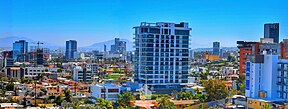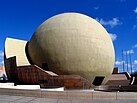Tijuana | |
|---|---|
Panoramic view of Tijuana | |
| Nickname: Gateway to Mexico | |
| Motto: Aquí empieza la patria ("The fatherland begins here") | |
| Coordinates: 32°31′30″N 117°02′0″W / 32.52500°N 117.03333°W | |
| Country | Mexico |
| State | Baja California |
| Municipality | Tijuana |
| Founded | 11 July 1889 |
| Government | |
| • Type | Ayuntamiento |
| • Mayor | Ismael Burgueño Ruiz (MORENA) |
| Area | |
| • City | 637 km2 (246 sq mi) |
| • Metro | 1,392.5 km2 (537.9 sq mi) |
| Elevation | 20 m (65 ft) |
| Population (2020) | |
| • City | 1,922,523 in Tijuana municipality 1,810,645 in Tijuana city alone[1] |
| • Rank | 8th in North America 2nd in Mexico |
| • Density | 2,832.5/km2 (7,336/sq mi) |
| • Urban | 2,002,000 (estimated)[2] |
| • Metro | 2,157,853[1] |
| Demonym(s) | Tijuanan (in Spanish) Tijuanense[3] |
| GDP (PPP, constant 2015 values) | |
| • Year | 2023 |
| • Total (Metro) | $61.0 billion[4] |
| • Per capita | $27,600 |
| Time zone | UTC−8 (PST) |
| • Summer (DST) | UTC−7 (PDT) |
| Postal codes | 22000–22699 |
| Area code | + 52 664/663 |
| Website | www.tijuana.gob.mx |
Tijuana[a] is the most populous city in the state of Baja California, located on the northwestern Pacific Coast of Mexico. Tijuana is the municipal seat of the Tijuana Municipality and the hub of the Tijuana metropolitan area. It has a close proximity to the Mexico–United States border, which is part of the San Diego–Tijuana metro area.
Tijuana is the 27th largest city in the Americas and is the westernmost city in Mexico. As of 2024, the population of Tijuana has increased to 2,297,000, reflecting a growth of 1.63% since 2023. While the city was second-largest nationally with 1,810,645 inhabitants.[9] The international metropolitan region was estimated at 5,158,459 in 2016,[10] making it the third-largest metropolitan area in The Californias, 19th-largest metropolitan area in the Americas,[11] and the largest bi-national conurbation that is shared between US and Mexico. The city is one of the fastest-growing metro areas in the country and rated as a "High Sufficiency" global city by the Globalization and World Cities Research Network.[12][13]
Tijuana traces its modern history to the arrival of Spanish colonists in the 16th century who were mapping the coast of the Californias. Following the division of the Californias after the American Conquest of California, Tijuana found itself located on an international border, giving rise to a new economic and political structure. The city was incorporated on 11 July 1889 as urban development began. The city has served as a major tourist destination since the 1880s. Today, Tijuana is a dominant manufacturing center for North America, hosting facilities of many multinational conglomerate companies. In the early 21st century, Tijuana has emerged as the medical device manufacturing capital of North America and is increasingly recognized as an important cultural Mecca for the border region of The Californias.[14] The city is the most visited border city in the world, sharing a border of about 24 km (15 mi) with its sister city San Diego. More than fifty million people cross the border between these two cities every year.
Despite its popularity as a tourist destination, Tijuana is a hotbed of crime, especially violent crime, due to the extensive presence of organized crime and Mexican cartels. It regularly ranks among the most violent cities by homicide rate. According to Statista in August 2023, Tijuana presently has the second highest homicide rate in the world.[15] The U.S. State Department maintains a travel advisory warning as of September 2023 relating to the city's "non-tourist areas".[16] Incidents involving the murder or kidnapping of foreigners since the 2000s have also sparked travel fears and affected Tijuana's status among international tourists.[17][18]
- ^ a b "SCITEL". INEGI. Retrieved 12 July 2024.
- ^ "Demographia World Urban Areas 16th Annual Edition" (PDF). Demographia. June 2020.
- ^ "The Tijuanense Identity". 21 April 2010. Archived from the original on 4 February 2018. Retrieved 4 February 2018.
- ^ "TelluBase—Mexico Fact Sheet (Tellusant Public Service Series)" (PDF). Tellusant. Retrieved 11 January 2024.
- ^ a b "Tijuana" (US) and "Tijuana". Lexico UK English Dictionary. Oxford University Press. Archived from the original on 9 August 2020.
- ^ a b c "Tijuana". Collins English Dictionary. HarperCollins. Retrieved 29 May 2019.
- ^ "Tijuana". Merriam-Webster.com Dictionary. Merriam-Webster. Retrieved 29 May 2019.
- ^ Jenkins, Logan (4 August 2016). "Watch your mouth in San Diego". The San Diego Union-Tribune. Archived from the original on 31 March 2019. Retrieved 29 May 2019.
- ^ "SCITEL". www.inegi.org.mx. Retrieved 12 July 2024.
- ^ "World Gazetteer – San Diego-Tijuana". Archived from the original on 1 October 2007.
- ^ "World Gazetteer – Metropolitan Areas of America". Archived from the original on 30 September 2007.
- ^ "The World According to GaWC 2020". GaWC – Research Network. Globalization and World Cities. Retrieved 31 August 2020.
- ^ Walker, Margath (January 2011). "Knowledge production and border nationalism in northern Mexico". Nations and Nationalism. 17 (1): 168–187. doi:10.1111/j.1469-8129.2010.00461.x.
- ^ Piore, Adam (2 September 2002). "How to Build a Creative City". Newsweek International.
- ^ Cite error: The named reference
:0was invoked but never defined (see the help page). - ^ "Mexico Travel Advisory". travel.state.gov. Retrieved 5 September 2023.
- ^ "65% of Southern Californians afraid to visit Tijuana, tourism officials say". KTLA. 12 October 2022. Retrieved 5 September 2023.
- ^ "Violence scaring off American tourists in Tijuana". CNN. Retrieved 5 September 2023.
Cite error: There are <ref group=lower-alpha> tags or {{efn}} templates on this page, but the references will not show without a {{reflist|group=lower-alpha}} template or {{notelist}} template (see the help page).











